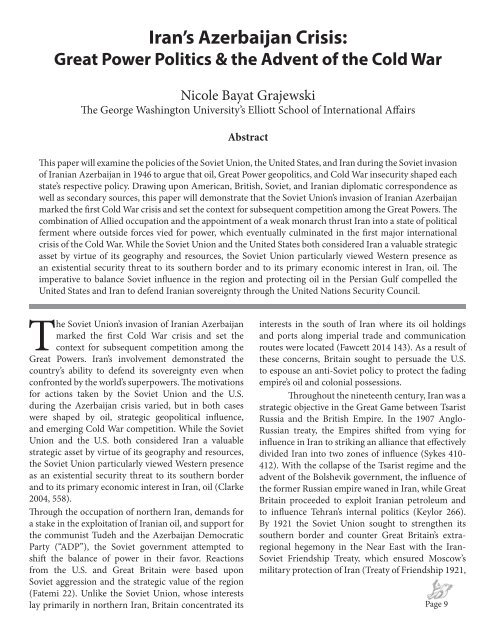You also want an ePaper? Increase the reach of your titles
YUMPU automatically turns print PDFs into web optimized ePapers that Google loves.
Iran’s Azerbaijan Crisis:<br />
Great Power Politics & the Advent of the Cold War<br />
Nicole Bayat Grajewski<br />
The George Washington University’s Elliott School of International Affairs<br />
Abstract<br />
This paper will examine the policies of the Soviet Union, the United States, and Iran during the Soviet invasion<br />
of Iranian Azerbaijan in 1946 to argue that oil, Great Power geopolitics, and Cold War insecurity shaped each<br />
state’s respective policy. Drawing upon American, British, Soviet, and Iranian diplomatic correspondence as<br />
well as secondary sources, this paper will demonstrate that the Soviet Union’s invasion of Iranian Azerbaijan<br />
marked the first Cold War crisis and set the context for subsequent competition among the Great Powers. The<br />
combination of Allied occupation and the appointment of a weak monarch thrust Iran into a state of political<br />
ferment where outside forces vied for power, which eventually culminated in the first major international<br />
crisis of the Cold War. While the Soviet Union and the United States both considered Iran a valuable strategic<br />
asset by virtue of its geography and resources, the Soviet Union particularly viewed Western presence as<br />
an existential security threat to its southern border and to its primary economic interest in Iran, oil. The<br />
imperative to balance Soviet influence in the region and protecting oil in the Persian Gulf compelled the<br />
United States and Iran to defend Iranian sovereignty through the United Nations Security Council.<br />
The Soviet Union’s invasion of Iranian Azerbaijan<br />
marked the first Cold War crisis and set the<br />
context for subsequent competition among the<br />
Great Powers. Iran’s involvement demonstrated the<br />
country’s ability to defend its sovereignty even when<br />
confronted by the world’s superpowers. The motivations<br />
for actions taken by the Soviet Union and the U.S.<br />
during the Azerbaijan crisis varied, but in both cases<br />
were shaped by oil, strategic geopolitical influence,<br />
and emerging Cold War competition. While the Soviet<br />
Union and the U.S. both considered Iran a valuable<br />
strategic asset by virtue of its geography and resources,<br />
the Soviet Union particularly viewed Western presence<br />
as an existential security threat to its southern border<br />
and to its primary economic interest in Iran, oil (Clarke<br />
2004, 558).<br />
Through the occupation of northern Iran, demands for<br />
a stake in the exploitation of Iranian oil, and support for<br />
the communist Tudeh and the Azerbaijan Democratic<br />
Party (“ADP”), the Soviet government attempted to<br />
shift the balance of power in their favor. Reactions<br />
from the U.S. and Great Britain were based upon<br />
Soviet aggression and the strategic value of the region<br />
(Fatemi 22). Unlike the Soviet Union, whose interests<br />
lay primarily in northern Iran, Britain concentrated its<br />
interests in the south of Iran where its oil holdings<br />
and ports along imperial trade and communication<br />
routes were located (Fawcett 2014 143). As a result of<br />
these concerns, Britain sought to persuade the U.S.<br />
to espouse an anti-Soviet policy to protect the fading<br />
empire’s oil and colonial possessions.<br />
Throughout the nineteenth century, Iran was a<br />
strategic objective in the Great Game between Tsarist<br />
Russia and the British Empire. In the 1907 Anglo-<br />
Russian treaty, the Empires shifted from vying for<br />
influence in Iran to striking an alliance that effectively<br />
divided Iran into two zones of influence (Sykes 410-<br />
412). With the collapse of the Tsarist regime and the<br />
advent of the Bolshevik government, the influence of<br />
the former Russian empire waned in Iran, while Great<br />
Britain proceeded to exploit Iranian petroleum and<br />
to influence Tehran’s internal politics (Keylor 266).<br />
By 1921 the Soviet Union sought to strengthen its<br />
southern border and counter Great Britain’s extraregional<br />
hegemony in the Near East with the Iran-<br />
Soviet Friendship Treaty, which ensured Moscow’s<br />
military protection of Iran (Treaty of Friendship 1921,<br />
Page 9


